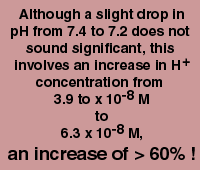
Clinical Correlates of pH Levels
Problem Set
Introduction
Bicarbonate as a buffer
|
The major buffering systems in the body are proteins (his, asp, glu), phosphate and bicarbonate. All three of these have pKa values lower than physiological pH. As a consequence, buffering capacity increases as the pH is lowered from the physiological range. Most physiological pH excursions occur in the acid direction. Hence, the low pKa of these buffering systems is poised to respond to metabolic acidosis. Of these three, only bicarbonate is in steady-state between production and removal, and this has important consequences. Thus, pH changes (or buffering) via this dynamic bicarbonate system are taking place on a background provided by the more static protein and phosphate systems. Production of Bicarbonate The acid components of the bicarbonate system (i.e. H+ and CO2) cross biological membranes rapidly, thus do not depend on complex transport kinetics. The anion (base) component (HCO3-) is transported rapidly in all cells via anion exchange. Consequently, the bicarbonate buffering system helps to maintain intracellular, as well as extracellular, pH. These acid components of the bicarbonate system are transported from the tissues to the lungs by Hemoglobin. Thus, this important protein participates in both the production and removal of metabolic acid. |
Clinical Correlates: Acidosis & Alkalosis
|
CO2 produced by metabolism is normally balanced by CO2 expired from
the lungs, resulting in no net production of H2CO3. However, certain
medically significant circumstances can throw the equation out of balance.
|
Treatment

Because respiratory problems are caused by alterations in CO2, the best treatment involves ventilation. If bicarb is used to raise the pH in cases of respiratory acidosis, the result can be fatal, since compensation is also working to increase the blood bicarb concentration. Because metabolic problems involve HCO3-, the best treatment is either bicarbonate infusion (for acidosis) or NH4Cl infusion (for alkalosis). NH4Cl dissociates into NH4+ and Cl-. The NH4+ (ammonium) is in equilibrium with NH3 (ammonia) and H+. Because ammonia is volatile, it is respired through the lungs, leaving behind H+ and Cl1 or hydrochloric acid, which lowers the pH. Often, metabolic acidosis is found in combination with respiratory alkalosis (e.g. compensated). This is a fragile situation because the buffering power is significantly reduced. |
The University of Arizona
January 14, 1999
Contact the Development Team
http://www.biology.arizona.edu
All contents copyright © 1998. All rights reserved.
